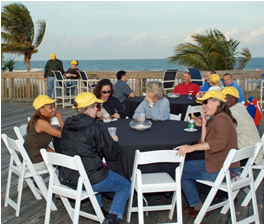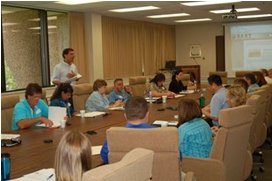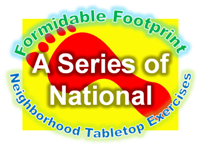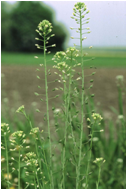
Vol. 7, No. 2, February 2011 |
 Printer-Friendly PDF Version Printer-Friendly PDF Version |
2011 Florida SART Planning Meeting
This Month in Altamonte Springs
Why attend? Network with 200 of the individuals and agencies you will need to know to prepare for, respond to and recover from an emergency situation in the agricultural and animal field.
 Hilton Orlando/Altamonte Springs
Hilton Orlando/Altamonte Springs
Not only will the latest information be available on local, state and national emergency planning efforts for animals and agriculture, but here are some of the agencies that will be represented – most of whom you will interact with if there is a disaster in your jurisdiction or if you are called upon to respond elsewhere in Florida:
- County Emergency Management Directors
- County Agricultural Extension Directors
- State and Federal Agency Personnel
- Private Veterinary and Response Groups and Personnel
Agenda
| Monday | |
| Noon - 1:00 pm | Registration |
| 1:00 - 5:00 pm | General Session |
| 5:00 – 7:00 pm | SART Networking Reception  |
| Tuesday | |
| 7:00 - 8:00 am | Complimentary breakfast for all attendees |
| 8:00 – 11:45 am | Problem-Solving Working Groups |
| Noon | Awards Luncheon |
| 1:00 – 5:00 pm | Field Training and Workshops |
| Wednesday | |
| 7:00 - 8:00 am | Complimentary breakfast for all attendees |
| 8:00 am - Noon | General Session |
Questions? Forgot to register? Check with Michael Turner (850) 410-6761 Michael.Turner@freshfromflorida.com or Joe Kight (850) 410-0920 Joe.Kight@freshfromflorida.com. A Florida green hotel and conference center, the Hilton Orlando/Altamonte Springs has a web site at http://www1.hilton.com/en_US/hi/hotel/ALTAHHF-Hilton-Orlando-Altamonte-Springs-Florida/index.do.
[top]
2011 Agroterrorism Preparedness Classes
Principles of Frontline Response to Agroterrorism and Food Systems’ Disasters
--------------------------------------------
Principles of Planning and Implementing Recovery
Have you or has someone from your staff attended DHS Certified Agroterrorism Courses? If not, here’s your chance for AWR-155 and AWR-156.
On-site registration begins at 8:00 am and, unless otherwise specifically advertised, workshops end at 4:00 pm. All courses are free. Additional sponsoring partners include the Institute for Food and Agricultural Sciences (IFAS-Extension), the Florida Department of Health and the Regional Domestic Security Task Forces. The following courses are still open:

AWR-155
Principles of Frontline Response to Agroterrorism
and Food Systems’ Disasters
Tuesday, March 15
Jacksonville Regional Operations Center
921 N Davis St. Building E, Jacksonville
Wednesday, March 16
USDA Farm Service Agency
4401 NW 25th Pl. Suite M, Gainesville
AWR-156 Principles of Planning and Implementing Recovery
Tuesday, March 22
Division of Emergency Management for Palm Beach County
20 South Military Tr., West Palm Beach
Wednesday, March 23
Alvin Sherman Library, Research and Information Technology Center
3100 Ray Ferrero Jr. Blvd., Fort Lauderdale
To register for a course or for more information go to the WIFSS website.
Registration:
http://wifss.ucdavis.edu/agroterrorism/classes/classesbydate.php
Course Information:
http://wifss.ucdavis.edu/agroterrorism/classes/course_desc.php
Contact John Terry (850) 410-6756 or John.Terry@freshfromflorida.com with questions.
| About AWR-156 Principles of Planning and Implementing Recovery |
|
This is the sixth course of the WIFSS Agroterrorism Preparedness Curriculum for Frontline Responders.  Using lessons learned from preceding courses in the curriculum, AWR-156 trains traditional emergency responders and members of the agriculture community on recovery operations, procedures and techniques following an incident of agroterrorism or food system disaster. This course provides the fundamental framework for orchestrating recovery following an incident of agroterrorism or food system disaster. Further, it: |
[top]
2011 Advisory Board Meetings Scheduled
 Art Johnstone, chief of FDACS' Office of Agricultural Emergency Preparedness, speaks to the SART Advisory Board about funding options and priorities.
Art Johnstone, chief of FDACS' Office of Agricultural Emergency Preparedness, speaks to the SART Advisory Board about funding options and priorities.
Florida SART has set the dates for its 2011 Advisory Board meetings. Please put Wednesday, April 6 and Wednesday, September 14 on your calendar. Meetings begin at 10:00 am and end no later than 2:00 pm. Both meetings will be held in the Board Room of the Florida Farm Bureau adjacent to Interstate 75 in Gainesville. The Farm Bureau cafeteria is available for those who wish to have lunch at the Bureau.
For information contact Joe Kight, Senior Management Analyst II/ESF-17 ECO, Division of Animal Industry, 407 S Calhoun St., Tallahassee, FL 32399-0800 (850) 410-0920 Joe.Kight@freshfromflorida.com.
[top]
2011 Governor's Hurricane Conference
"25 Years: Learning from the Past, Preparing for the Future"
“Over the past 25 years we have seen collaborative and cooperative relationships develop among networks of public, private and nongovernmental organizations. Lessons learned from tropical events that have affected Florida have provided opportunities to build relationships, establish trust and develop programs that have become the building blocks of safety for the citizens of the Sunshine State.”

The 2011 Governor’s Hurricane Conference (GHC www.flghc.org) will be held at the Ft. Lauderdale-Broward County Convention Center from May 15-20. Training sessions are organized under the following headings: Business & Industry, Communications & Public Information, Emergency Management, Emergency Services, Health & Human Services, Logistics & Resource Support, Policy & Planning and Recovery & Mitigation.
Of special interest to SART members might be:

- TS ES2. Community Emergency Response Team (CERT) Train-the-Trainer (G317) – Linda McWhorter: prepares emergency services instructors to deliver CERT Basic Training to citizens. A train-the-trainer course focusing on preparing instructors to deliver CERT basic training, focusing on safety, teamwork and the CERT role in an overall community Emergency Operations Plan.
- TS ES4. Standardized Credentialing Program for Management of Animal Emergency Response and Recovery – John Wilson: prepares participants to utilize the Animal Emergency Responders (AER) Resource Typing and Credentialing templates, position task books and the Resource Ordering and Status System (ROSS) to manage an animal-related disaster response and recovery. This course supports the development of collaborative resource sharing plans and agreements to effectively manage animal-related disaster response and recovery.

Session organizers Linda McWhorter and John Wilson are GHC Vice Presidents. McWhorter is Regional Coordinator Supervisor, Florida Division of Emergency Management. Wilson is Director of the Lee County Division of Public Safety. For more information contact GHC at (727) 944-2724: Lynn Daines, Executive Vice President ghclynn@verizon.net, Martha Tripp, Director of Administrative Services ghcmartha@verizon.net and René Daines, Administrative Assistant ghcrene@verizon.net.
[top]
Hurricane Griffin About to Make Landfall
The 2011 Florida statewide Hurricane Exercise, Hurricane Griffin, will be held during the week of May 23-26, 2011. The hazards will be a hurricane, possible tornados, flooding and wind damage. Once the hurricane has made the first landfall, the focus will shift to response, recovery and restoration of services for the southeast Florida area of operations.
Joe Kight, Florida ESF-17, says SART’s stated goal in this exercise will be to see how quickly it can respond: establish a temporary companion animal shelter in the affected area using one of the MARE units and perhaps a SARC team. “We would move equipment and volunteer resources to a location where we would assemble and then disassemble a shelter operation in one day,” he says.
Additional challenges will be to exercise the ESF-17 ability to respond to a 1,000-head dairy that has been hit by a tornado associated with the hurricane.
Conducted over a one week period May 23-26, exercise players will represent all state agencies as well as all county emergency management. The overall point of contact is Necole Holton (850) 413-0261 Necole.Holton@em.myflorida.com. The ESF-17 contact is Joe Kight at (850) 410-0920 Joe.Kight@freshfromflorida.com.
Formidable Footprint
The Disaster Resistant Communities Group www.drc-group.com was established to provide disaster planning and preparedness, response, recovery and mitigation services to local government agencies and departments as well as community and faith-based organizations.
Our Philosophy is to:
- Develop innovative concepts to meet the needs of the emergency management community.
- Enhance a community's ability to plan and prepare for, respond to, recover from and mitigation the effects of future disasters.

Formidable Footprint - A Series of National Neighborhood Tabletop Exercises
Led by the Disaster Resistant Communities Group a team of national, regional and state organizations has undertaken an effort to develop, facilitate and evaluate a series of disaster exercises for neighborhood-based organizations entitled "Formidable Footprint - A Neighborhood Tabletop Exercise."
This series of exercises will serve as an opportunity for
- Citizen Corps
- Community Emergency Response Teams
- Map Your Neighborhood Teams
- Neighborhood Associations
- Neighborhood Emergency Response Teams
- Neighborhood Watches
along with other community and neighborhood organizations to assess the ability of neighborhood residents to work together to prepare for, respond to and recover from a variety of natural disasters which can affect the lives of neighborhood residents.
For information contact Disaster Resistant Communities Group, 6224 Wake Robin Lane, Tallahassee, FL 32309 (850) 241-3565 - info@drc-group.com.
[top]
Tim Manning on Camelina sativa
“I want to help create alternative revenue crops for people in agriculture.”
Tim Manning, State Director, FSA
 The US Navy successfully tested several bio-fuels of the type developed from camelina sativa.
The US Navy successfully tested several bio-fuels of the type developed from camelina sativa.
Could an unknown weed save agriculture in Florida?
A crop under investigation for years in Montana and elsewhere holds significant potential for Florida agriculture. And you probably have never heard of Camelina sativa. Camelina has two potentials, in the growing alternative fuels market and as cattle feed supplement.
As a bio-fuel and bio-lubricant camelina-based jet fuel may reduce carbon emissions from jets by about 80 percent! The US Navy chose camelina as the feedstock for their first test of aviation bio-fuel and successfully operated a static F414 engine, the engine for the F/A-18, in October 2009 at Naval Air Station Patuxent River, Maryland. The US Air Force also began testing the fuel in 2010.
KLM, Royal Dutch Airlines, was the first airline in the world to operate a passenger-carrying flight using biofuel. On the 23rd of November 2009 a Boeing 747 flew, carrying a limited number of passengers, with one of its four engines running on a 50:50 mix of bio-fuel and kerosene.
Camelina is approved as cattle feed supplement in the US as well as an ingredient (up to 10 percent) in broiler chicken feed and laying hen feed.
Both camelina seed and meal have agricultural potential. Camelina seed ranges from 37 to 41 percent oil content and this oil is high in omega-3 fatty acids. Meal, the by-product when the oil has been extracted, has significant crude protein content. (Medical research indicates that a diet abundant in omega-3 fatty acids is beneficial to human health.)
“Where Montana is growing one crop per year,” Manning says, “Florida can grow two crops a year.”

“Camelina grown in Florida produces the highest yields in the country, can be grown in fall and winter and is very drought and cold tolerant,” says Bill Vasden, Jr., Chairman of the Florida Feedstock Growers Association.
Vasden says market demand for these energy crops exceeds supply, so it has been very profitable for his operation. “We look to 2500 acres, without any government subsidy, to gross $2.8 million when farmed with two crops of camelina and one crop of kenaf, and those are pretty impressive figures,” he explained.
[top]
Caught On Radar
Several items to keep on the radar screen because they fall within the “all-hazard disaster” planning, preparation and response scope of SART and its cooperating partners:
1. Field Responders: Comfort versus Survival
“Many of us have come to consider comfort to be our greatest need. Comfort is not essential, but people often value it much too highly in survival situations. You must value your life more than your comfort and be willing to tolerate heat, hunger, dirt, itching, pain – almost any discomfort. If you expose yourself to a bitter cold wind because you have a swollen ankle and think you can’t walk to a nearby shelter, you have your priorities out of order. Reason is the key to changing your attitude – reason that identifies the pain of walking as a temporary problem compared to freezing to death.” J. Wayne Fears, Complete Book of Outdoor Survival
2. New Email Addresses at FDACS
Please note that new email addresses can now be used for members of the Dept. of Agriculture & Consumer Services. State ESF-17 coordinator Joe Kight is now Joe.Kight@freshfromflorida.com. Art Johnstone, Director of the Office of Agricultural Emergency Preparedness is now Art.Johnstone@freshfromflorida.com. Michael Turner, SART Planner is Michael.Turner@freshfromflorida.com and John Terry, Planner is John.Terry@freshfromflorida.com.
3. Alachua County Post-Disaster Recovery Plan
The Post-Disaster Recovery Plan (PDRP) for Alachua County is posted on-line. View the pdf at http://alachuacounty.us/Depts/PublicSafety/Documents/em/. A quick read-through indicates neither a substantive reference to agriculture nor to animals. For information contact Alachua County Emergency Management Director David Donnelly at 352-264-6500 or dad@alachuacounty.us.
The most devastating disaster to date was the 1896 Category 3 Hurricane that made landfall in Cedar Key, Florida and left death and destruction as it swept through the state in a northeast direction on September 29th. The storm left few houses standing, and caused 1,500 injuries or casualties, and approximately $3.8 million in damages. It caused impacts in Alachua, Columbia, Duval, Levy and Nassau counties.
According to the National Oceanic and Atmospheric Administration (NOAA), National Climatic Data Center (NCDC), nearly 400 hazard incidents occurred in Alachua County from 1957 to 2009.
4. Dates for CRP General Sign-up Announced
General sign-up for USDA’s Conservation Reserve Program is March 14-April 15 at county Farm Service Agency offices.

“Over the past 25 years, CRP’s benefits – cleaner water, improved air quality, better habitat for wildlife, wildlife viewing opportunities and a huge reduction in soil erosion – have grown thanks to unexpected, but welcome improvements to our natural resources," says FSA State Director Tim Manning.
FSA ranks potential CRP lands using an Environmental Benefits Index. The Index considers five environmental factors (wildlife, water, soil, air and “enduring benefits”) as well as cost.
In addition to general sign-up, CRP's continuous sign-up program is ongoing. Continuous acres represent the most environmentally desirable and sensitive land. For more information, visit http://www.fsa.usda.gov/crp or contact Mark Cotrell, Florida FSA Public Affairs at (352) 379-4562 mark.cotrell@fl.usda.gov.
5. Get Your Kids Involved
Every parent wants to stimulate their kid’s thinking and natural inquisitiveness. Here’s a little quiz from the October 2010 issue of Florida Fish & Wildlife News www.fwfonline.org. (Answers at end of this month’s Sentinel.)
Questions
1. How many kinds of skunks live in Florida?
2. What bad thing might a raccoon do?
3. Which bird can fly backwards?
[top]
About the SART Sentinel |
The SART Sentinel is an E-mail newsletter prepared monthly by the members of the Florida State Agricultural Response Team. Past issues of the Sentinel are archived on the Florida SART Web Site www.flsart.org. If you have a story or photo that you would like to have considered for publication in the SART Sentinel please contact the Editors. Editor: Rick Sapp, PhD, Technical Writer, Florida Department of Agriculture & Consumer Services, Division of Animal Industry rsa5@cox.net Associate Editor: Joe Kight, State ESF-17 Coordinator, Florida Department of Agriculture & Consumer Services, Division of Animal Industry Joe.Kight@freshfromflorida.com [top]Answers to “Get Your Kids Involved” Quiz 1. Two of the eleven species of skunks live in Florida. Both the Eastern Spotted Skunk and the Striped Skunk can be found statewide (except for the Keys). 2. They are regarded as predators of sea turtles nests. Raccoons are prevalent in the lower 48 states, including Florida. The main reason for raccoon deaths is considered to be car accidents. 3. The Hummingbird. Not only can hummers fly backward, they can hover in midair, and can also fly straight upward, and even upside down. These maneuvers are possible because of a unique design that allows the wing to move very freely and in almost any direction at the shoulder. Soaring is the only maneuver they can not perform. Hummingbirds live only in the Americas. Of the 338 species known, 16 are found in the United States and 3 occur in Florida. Black-chinned and rufous hummingbirds occasionally can be seen in Florida during the winter. The ruby-throated hummingbird is by far the most common hummer in the state. [top] |
